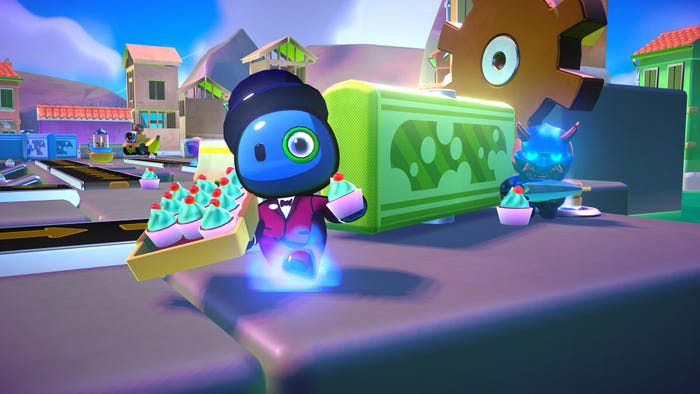
Featured Blog | This community-written post highlights the best of what the game industry has to offer. Read more like it on the Game Developer Blogs.
Taking a look at generational thought to analyze what the traits of Generation Y mean for game design as we go forward into an increasingly Y-filled industry (and culture).

We're a generation that can sit in someone's living room and play plastic instruments and sing into microphones with all of our friends. We devote hundreds of hours of time into building our characters and forging relationships with people in online fantasy games.
We play games on our phones, in our web browsers, on table-tops, and, sometimes, with nothing other than our bodies and our voices in games like Mafia. We like having people around us, we like doing a variety of stuff, and we don't particularly have patience for any one activity for a long period of time.
Anyway. 'sup, we're Generation Y.
As our generation grows from our current teenage/twenty-something years we will, eventually, transform the things we make and consume to reflect the way we've changed from the generation before. More established industries are familiar with the changes brought about by a generation cycle, but digital games and industry which makes them are still young.
If we take what many consider to be the birth time-frame for Generation Y (1982-2003) then the oldest members of Generation Y are around twenty-seven years old right now. For those of us that grew up with gaming as a primary hobby, we grew up with the games made by Baby Boomers and young members of Generation X.
If we pin the developmental maturity for truly critical thinking about the games we are playing somewhere around the age of sixteen-to-eighteen years old, then the games that filled this developmentally important time around 1998-2000 were primarily developed by Gen X developers (with a not-insignificant chunk of Boomers).
Giving a talk at an IGDA meeting in Montreal, Clint Hocking pointed out that in 2000 roughly 80% of the game industry was composed of members of Generation X. In the same talk, Hocking pointed to a list of the Top 50 Games of All Time on GameRankings.com and determined that 35 of them were released during or after the year 2000.
"What is so awesome about these hardcore, immersion-focused, punishing single-player games? Is it that Generation X finally figured out what makes games great and the future of game development is just replicating that? I don't think so. The reason that these games are overwhelmingly considered to be great is because the people making them, the people playing them, and the people rating them are the same fucking people. We are Generation X and we do not play nice with others.
Generation Y, however, does play nice with others. We are a generation whose most defining characteristic is our general approach to socialization. Where Generation X does not "play nice with others," Generation Y does not take well to isolation. We're used to constant feedback from others (preferably praise) and we prefer the dynamic of a team. Years and years of academic life where tasks were group projects, paired assignments, and peer review have raised us with a familiarity and comfort in group work.
As Generation Y gets older, the continual exposure to group activities and group projects throughout academic life manifests in unique ways. We're a generation in constant communication with one another; we text, we Twitter, we Facebook, we use just IM conversations with ease, and it feels weird to work at a computer without an internet connection.
Members of Generation Y are generally perceived to be sheltered, stressed, and entitled as a result of special treatment or attention due to the focus of parents who were acting opposite of the lax parenting in the 60s-70s (Wilson/Gerber, 2008 [PDF]). The combination of these factors goes a long way to explaining the popularity of the games created by Generation X.
Those "hardcore, immersion-focused, punishing single-player games," as Hocking described them, were all Generation Y wanted out of our entertainment. We wanted to be immersed in worlds where we played as the protagonist in one of our many favorite pop culture power fantasies.
In 2000, the oldest members of Generation Y were just finishing high school. What lay ahead was the livelihood of a new generation; Ys were going to college or going straight into the work-force and starting to come into their own. Those same sheltered, stressed, and entitled kids now had an abundance of opportunities outside the realm of high school.
Going forward, the prominent "trophy kid" mentality of Generation Y creates a unique type of individual: hard-working, achievement-focused, but with a sense of entitlement due to Generation X's reaction to the lax parenting of the Baby Boomers. Wilson and Gerber continually make reference to the Y desire for quick feedback and reward for their time and efforts. Furthermore, Y demands variety as Richard Sweeney [DOC] elaborates:
Millennials expect a much greater array of product and service selectivity. They have grown up with a huge array of choices and they believe that such abundance is their birthright.
If Generation Y was a video game, it would be World of Warcraft.
World of Warcraft is a game filled with vibrant people, feeding on a variety of common fantasies, providing constant feedback, and offering an abundance of activities each with their own systems and ways of providing feedback and rewards. In a given World of Warcraft play session, the following activities are possible:
Sitting around in a major town and simply partaking and interacting with the societal microcosm which exists there.
Partying up with others (either well-known or not) for group questing/raiding.
Trading goods personally or through a third-party (the Auction House can be seen as an entire game in and of itself).
Exploring the world either for exploration's sake or to search for items/people.
Engaging in the entirety of the crafting series of systems such as gathering ingredients, crafting actual items, and selling/trading home-made goods with others.
Character customization through weaponry, clothing, and gaining experience/leveling. Most notable here is the display of one's avatar in comparison to others and treating the avatar as a badge of pride within the game's universe.
World of Warcraft's tremendous popularity isn't a surprise considering its features and its target demographic. It, quite literally, has everything desirable to appeal to a significant amount of the Generation Y crowd. It offers a variety of activities, places importance on the social aspects of gaming, and offers an innumerable amount of forms of rewards. Most importantly, it can be played in almost any amount of time. Players can sign on for ten minutes just to momentarily hang out with their guild, run a quick quest, gather a few ingredients for their crafting work, and then sign off.
If the features that attract the Gen Y populace as a whole are a quick, rewarding core feedback loop, an ability to have a quick session of a game (even if it could turn into a long one) to fit into the busy, entertainment-laden lives of the Y socialites, does that start to rule out the role of deep, time-consuming game experiences like Far Cry 2? As up and coming designers of games that our generational contemporaries will be playing, the last thing we want is for our own generation to sabotage our ability to make games like the ones we grew up with.
As much as we want to have our own style of design and play, we don't want to eschew the years of work and research put forth by the Boomers and Gen Xs that paved the way for the work we have done and will do in the future. We grew up playing games like System Shock, Baldur's Gate, Half-Life, and so on, and these are the games that shaped the way we play and think about games. That said, none of these are games that provide an abundance of quickly-accessible instantly gratifying moments.
The answer, I think, is changing the way we make games to fit into a player's life. World of Warcraft would be nothing if it didn't offer the abundance of possible ways to play the game (from solo questing, to massive group raids, to solely socialization). The recently-released Trials HD would be far less interesting of a game to me if it didn't display everyone on my friends list as they relate to my progression through a given level.
And look at Guitar Hero: back when it was just a guitar game for one or two people it was moderately popular, but it completely exploded when Rock Band hit and allowed for more widespread social appeal due to the variety of roles it allows people to play. It seems necessary to change how we think about games by appealing to changes in a primary "gamer" demographic (if such a thing exists) while still evolving how we think about what we personally want out of games.
For instance, it seems like it would be a misstep, given what we know about gaming habits on the Xbox 360, to release a game which completely fails to acknowledge the outside world despite friends and messages and game invites popping up on the screen at any time.
Microsoft's treatment of Xbox Live for this console generation was one of the most forward-looking developments in the game industry. Xbox Live arcade offered players a friends system that told people when they're friends were online, what they are playing, and what they're doing in that game.
On top of that, Xbox Live added a persistent form of achievements to the platform that could be achieved by players and viewed by that player's friends was a brilliant design decision. It essentially forced all games on the platform to acknowledge that most players weren't playing games in a vacuum anymore. Achievements swiftly offered solutions to the kinds of problems that designers were going to run into this console generation: the difficulty in making a "hardcore, immersion-focused, punishing single-player game" sticky to a generation of gamers who were now entering a part of their lives where time would become a commodity.
Going along with the type of social gaming that the Xbox 360 encourages, a surprising number of major games of this generation have attempted to adapt to the more social nature of Generation Y gamers. Games like EA Montreal's Army of Two are based almost entirely on the assumption that two players will be playing the game cooperatively; if not, an AI partner will fill in, but the game is designed and written in such a way as to make its emphasis on two human players clear.
The more bizarre case is Capcom's Resident Evil 5. Resident Evil is a wholly single-player series that was "reinvented" in Resident Evil 4 with a game design that placed even more emphasis on a single player (unlike RE1 and RE2, RE4 had no option to play as multiple characters). Resident Evil 5 took the Resident Evil 4 gameplay and restructured to work as cooperatively-dependent as Army of Two -- a step that even the co-op heavy Gears of War games swayed away from.
It's hard to know how to properly evolve game design in ways that will fully appeal to the changing demographic as we transition from the, as Hocking dicussed, primarily Generation X occupied roles of player, developer, and reviewer to that of the Generation X/Y coexistence to the period where Generation Y is the dominate force in the marketplace.
What does seem somewhat helpful going forward is recognizing that the people who are growing up now have a different set of expectations for what games are and what they should be than the teenagers from a decade ago. And, at some point, games will change to match, but what's to be decided is how.
Read more about:
Featured BlogsAbout the Author(s)
You May Also Like








